This February and March, we’re taking a trip back in time to review the fourth season of The X-Files and the first season of Millennium.
The X-Files is a show that sometimes has difficulties when it comes to portraying minorities.
There are lots of episodes that offer insightful and thoughtful explorations of isolated subcultures, without veering into offensive stereotypes or awkward cliché. Fresh Bones and Hell Money are two examples of the kinds of stories that do offer those sorts of interesting and respectful depictions of minorities. In contrast, the show can sometimes seem a little close-minded and xenophobic. Excelsis Dei, Teso Dos Bichos and Teliko are episodes with somewhat questionable depictions of other cultures.
Writer John Shiban likes his horror tropes. He adores the classic horror movie trappings, and revels in a very old-school approach to scary stories. Unfortunately, the horror genre has an unfortunate history of exploitation and racism when it comes to the portrayal of “the other.” The easiest way to make something scary and unknown is to make it foreign, suggesting that the outside world is filled with horrors and monstrosities. Shiban would hit on this trashy exploitation vibe repeatedly during his tenure on The X-Files.
El Mundo Gira is very much a companion piece to Shiban’s other stories about foreign monsters – the indigenous cat-people of Teso Dos Bichos and the butt-dwelling Indian fakir of Badlaa. It is a not a story set in the world of Mexican-American immigrants; it is a story set in a clumsy stereotypical depiction of the world of Mexican-American immigrants, as channelled through unfortunate racial stereotypes.
To be fair to El Mundo Gira, it is trying to temper its racism. It is trying to be clever. El Mundo Gira is structured as a story within a story; multiple varying and conflicting accounts of a feud between two brothers that happened to draw in the myth of the Chupachabra and two iconic FBI agents. The opening scene features a community of immigrants gathering around to tell the story. “Quiet!” Flakita insists.“It was a terrible thing. You’re not going to believe me, even when I tell you. Some say it is a story, a fairy tale. But I saw it. I saw it with my own eyes.”
At the end, the episode returns to this idea of folklore and storytelling, featuring no less than three varying accounts of how things ultimately played out. The story that Flakita told is re-told, elaborated upon and distorted – just as she elaborated upon and distorted the truth. Finally – as if to prove the episode isn’t racist – El Mundo Gira circles back around to Mulder and Scully recounting their own version of events to Skinner, as if to suggest that Mulder is just as fanciful as the community of Mexican-American immigrants featured in the story.
This is not a terrible idea, in theory. However, the execution is terrible. Darin Morgan had played with similar ideas in Jose Chung’s “From Outer Space.” John Shiban is no Darin Morgan. El Mundo Gira is no Jose Chung’s “From Outer Space.” Morgan’s script committed to its postmodern ideas, offering multiple versions of the truth – conflicting and overlapping, intersecting and diverging. Instead, only the beginning and end of El Mundo Gira play with this idea of folk lore and fairy tales, a rather lazy attempt to give the episode weight.
Are we to assume that the entire episode is Flakita’s version of events? That would account for the exaggerated nature of the story, the coincidences and the stereotypes; maybe El Mundo Gira is not meant to be poorly-constructed story, maybe it is meant to be a parody of a poorly-constructed story. However, it seems unlikely. How could Flakita account for events she did not witness and would not have been reported in the news? How could she know enough about Mulder and Scully to characterise them so effectively?
To be fair, there is evidence to suggest this is meant to be a faintly stylised episode. “Mulder, what we’ve walked into here is a Mexican soap opera,” Scully tells Mulder. However, if El Mundo Gira was intended as a postmodern mash-up, it is a phenomenally racist attempt, as Karen Backstein notes in Flexing Those Anthropological Muscles:
Shunting aside the show’s usual realistic performances and settings (which heighten the horror by basing it in an everyday context), here the actors perform melodramatically, while the reflexive, somewhat postmodern narrative alludes to the popular Mexican telenovelas. Yet, in the context, everything seems overwrought, a reaffirmation of stereotypical Latin emotionalism.
El Mundo Gira never subverts or explores stereotypes; it plays them entirely straight. There is a brother out for revenge, a community terrified of superstition, a corrupt law enforcement official, a murdered lover. El Mundo Gira even takes its title from a popular American soap opera – As the World Turns – translated into Spanish.
There is a stunning amount of racism on display here. Some of it could arguably be intentional – immigration official Lozano seems to genuinely detest the Mexican-American immigrants. “Whenever their passions become inflamed, they resort to violence,” he assures Mulder. “And then they cannot turn to the law, so they make up these fantastic tales.” Later, as Eladio is taken away, Lozano urges Mulder to file the paperwork anyway. “By the time they process it, he’ll probably be back here, anyway.”
This feels like a conscious attempt to establish Lozano as an unlikeable character, to set up his betrayal of Mulder and Scully at the climax. However, Lozano is just as much a stereotype as any of the other Latin characters. He is superstitious and irrational. “A man cannot live with vengeance in his heart,” he advises Mulder as they track down Eladio and Soledad. “My mother used to say that blood should be left to cleanse itself. God curses the man who stands between two brothers.” Ultimately, Lozano betrays his responsibility to enable superstition and irrationality.
More than that, Mulder and Scully hardly come across as sympathetic here. There are a points when Mulder seems almost racist. When Scully asks how long ago the event occurred, Mulder replies, “Tres dias. Muy incredible, no?” Later on, when Scully asks for Eladio’s version of events, Mulder offers a stereotypical broken English key-word summary of Eladio’s account of the day in question. Towards the end of the episode, Mulder declares, “I don’t know what to believe any more, Scully. These people sure love their stories.” What does Mulder mean “these people”?
More than that, it makes Mulder sound dismissive and frustrated, as if angry at these community issues that distract from his own pursuit of the Chupacabra. To be fair to El Mundo Gira, the episode acknowledges the sorts of issues and difficulties facing these sorts of immigrant communities. As with Teliko, Mulder and Scully acknowledge that conventional law enforcement tends to overlook these disenfranchised groups. “Local cops don’t care, Scully,” Mulder remarks early in the episode. “I don’t know who does.”
In fact, El Mundo Gira works rather hard to tie these issues back into the larger themes of the series, transforming both Eludio and Soledad into figures that resemble the show’s conventional “grey” alien. The alien is more human than we would like to admit. “Mulder, I know you don’t want to hear this, but I think the aliens in this story are not the villains,” Scully explains at one point. “They’re the victims.” Lozano also makes the connection between extraterrestrial aliens and illegal aliens. “They are strangers here. They feel hated, unwanted.”
However, while this is a very clever way of connecting El Mundo Gira into the show’s larger concerns, it falls into the same trap as Teliko. In treating the foreign as “alien”, it exoticises it. As with Teliko, there is a rather unpleasant disease metaphor at the heart of El Mundo Gira, with Eludio and Soledad acting as infectious agents carrying a deadly contaminant across California. Much like the murders in Teliko were original investigated by the Centre for Disease Control, Mulder and Scully quickly determine that the brothers are contaminating those they encounter.
Again, this makes sense from a storytelling perspective – a race against time to stop a plague-carrier is thrilling television, as F. Emasculata demonstrated. However, it also has some unfortunate subtext, as Paul A. Cantor notes in Gilligan Unbound:
Indeed, the episode once again stresses the porousness of borders in the modern world – the migrants seem to move back and forth between Mexico and the United States with ease. Lozano at first thinks Mulder is wasting his time when he tries to prevent one of the brothers from returning to Mexico. But then the immigration official adds: “File your paperwork. By the time they process it, he’ll probably be back here anyway.” As in many X-Files episodes, including those dealing with the extraterrestrials’ plan to use a virus to disseminate their influence on Earth, the central symbol of El Mundo Gira is infection, and the migrant workers seem to pass across national borders as easily as the microbes that spread disease. Face with the new migratory world of the globalised economy, the nation-state seems powerless.
Tying the infection to migrant workers feels a little unfortunate, adding a clumsy xenophobic element to the narrative – as if to suggest that the United States itself is being infected by outside elements.
More than that, Scully even cites AIDS in her discussion of the infection. The plot involves the weakening of victims’ immune systems to the point where a relatively harmless fungus devours them. As William A. Calvo-Quiros contends in Sucking Vulnerability, it is hard to clumsy and highly loaded metaphor:
The episode is about the notion that immigrants are dangerous, that they cross the border carrying with them diseases, including social ones. They are presented as extremely infectious, where any one can be contaminated, even those reaching out to help there. What is more, this is not just any disease, but rather “a new strain… [one that is] very dangerous.” One that humanity has never seen before, and consequently it requires unique and exceptional measurements. Especially because unauthorised immigrants, like the Chupacabras, cannot be cured, captured, changed or domesticated. The fact that the Chupacabras carry a disease that attacks the immune system, just as AIDS does, is particularly important as a reflection on the imaginary life-threatening nature of immigrant existence in America.
In the mid-nineties, America was still terrified about the spread of AIDS and the potential threat posed by Ebola or other infectious diseases. Teliko had played on these fears as well. Tying them to immigrants feels like the sort of awkward rhetoric that fuels anti-immigration campaigns.
That said, it should be noted that the mid-nineties had also seen a surge in migration from Mexico into the United States. As a result, El Mundo Gira is playing on very contemporary fears – an example of how The X-Files is undeniably of its time. This increase in migration from Mexico into the United States was linked to a number of different factors. For example, the “wet foot, dry foot” policy towards Cuban refugees introduced by the United States in 1995 had led to the emergence of so-called “dusty foot” migrants – Cuban refugees landing in Mexico and crossing into the United States by land.
At the same time, the devaluation of the Mexican peso in 1994 had led to an increase of in the number of emigrants heading north of the border. In December 1994, it was reported that the peso had lost fifty percent of its value; in early 1995, it was reported that illegal immigration from Mexico into the United States had increased by thirty percent. The 2000 census revealed that the foreign-born population of the United States increased by over eleven million during the nineties, with Mexican immigrants accounting for almost half of the increase.
Against this backdrop, the number of migrant workers employed illegally in the United States increased as the wages of those migrant workers decreased. At the same time, it seemed like anti-immigrant policies and politics were gaining traction. As Nazli Kibria, Cara Bowman and Megan O’Leary note in Race and Immigration:
The campaign to “secure our borders” moved ahead in 1996 with the passage of the Illegal Immigration Reform and Immigrant Responsibility Act (IIRIRA). In conjunction with the 1996 Personal Responsibilit and Work Opportunity Reconciliation Act, IIRIRA reduced immigrant access to social safety-net programs. It increased border personnel, authorised construction of further barriers on the Mexican border and stiffened penalties for various immigration offenses. It also toughened deportation procedures and tightened the rules for the sponsorship (for permanent residence) of family members by citizens of the United States. The Antiterrorism and Effective Death Penalty Act (AEDPA) of 1996 further increased the enforcement authority of the federal government by limiting judicial review for most categories of immigrants subject to deportation. In short, the last decade of the twentieth century saw the growing criminalisation of irregular migration through increasingly punitive enforcement measures.
In this context, the decision to categorise immigrants as “alien” and “infectious” feels a little clumsy and ill-judged. El Mundo Gira feels positively reactionary in its portrayal of Mexican-American culture, and in its portrayal of immigration in the United States.
And then there is the Chupacabra. In reality, El Mundo Gira has very little to do with the case of the “Mexican goatsucker.” The opening scene features one dead goat carcus, but El Mundo Gira is not a story about cryptozoology; it is a story about the carrier of infectious disease. El Mundo Gira could easily be told without reference to the Chupacabra, instead as a more direct riff on F. Emasculata. There is a rather uncomfortable feeling that the only reason that El Mundo Gira labels Eladio as the Chupacabra is because this is a story featuring migrants from south of the border.
Would El Mundo Gira be about leprechauns if it were set in the Irish-American community? After all, the bodies have a patriotic greenish glow to them, Eladio proves quite illusive and difficult to catch, and the case begins with a rather strange rainfall that could easily have lead to a rainbow. Sure, these would all be tenuous connections, but no more tenuous than the various links El Mundo Gira actually makes. Sure, Eladio eventually morphs into a form resembling the Chupacabra, but characters refer to him as such long before that point.
Perhaps the Mexican-American community is familiar enough with the process that they recognise Eladio is in the early stages of a transformation. However, this raises even more questions. How come this transformation is unique to this particular culture? “Fortean events” have occurred throughout history, so it seems strange that they would only have this sort of effect in these communities, but often enough for it to become a process with which members are intimately familiar. More than that, how come nobody has ever bothered to share that particular detail of the Chupacabra myth outside the subculture?
It feels like El Mundo Gira decided to set a story in the migrant worker community, and decided that the Chupacabra would be the focus of the story; even if the creature had no real resemblance to the Chupacabra of legend. To be fair, The X-Files has never been particularly good at cryptozoology; for every Quagmire, there is a Jersey Devil. Similarly, the show does not have a high success rate with classic monsters like vampires (3), werewolves (Shapes, Alpha) or ghosts (Shadows, Excelsis Dei). So focusing on an infectious agent makes sense, even if insisting on working in the “Chupacabra” feels like a poor choice.
Still, the Chupacabra is an absolutely fascinating piece of modern mythology. The creature was a relatively recent invention at the time that El Mundo Gira went to air, having been first officially reported in Puerto Rico over the summer of 1995. Perhaps the defining witness statement was given by Madelyne Tolentino in August 1995:
Tolentino said the chupacabra she saw had dark eyes that went up its temples and spread around the sides; it was about four feet tall, walked like a human on two legs, and had thin arms and legs, with three fingers and toes at the end of each limb. It had no ears or nose, but instead two small airholes. She also noted a row of distinctive spikes on the creature’s back. It stood outside a window, then moved into the road and leaped off into tall grass in a neighbouring vacant lot. Her account appears in Scott Corrales’s book Chupacabras and Other Mysteries, and is summarised and paraphrased in dozens of books and websites as a credible and important sighting.
Ultimately, Benjamin Radford would suggest that Tolentino’s sighting was a hoax – baring an uncanny resemblance to the creature from the contemporary movie Species. It is worth noting that sightings of the Chupacabra spread quickly northward – as if the creature were migrating itself. It was reported in Mexico in early 1996. High-profile sightings in Florida in March and July 1996 confirmed that the rumour had reached the United States.
To be fair, there is some historical precedent for the monster. These sorts of creatures have been reported since the mid-seventies, although the word “chupacabra” was used rather infrequently in contemporaneous reports. The name originally applied to a the European nightjar. Nevertheless, the nineties saw a boom in coverage of the creature, propelling it to monster stardom. As The Fortean Times noted in 2002:
Not since the advent of crop circles has a strange phenomenon been so quickly assimilated into popular culture. Chupacabras is now equal to the Loch Ness Monster or Bigfoot as a cultural icon.
The creature became a sensation. In 1996, director Gilberto de Anda released a low-budget Mexican horror film to capitalise on the trend, El Chupacabras. The X-Files proved to be relatively quick on the draw here, delivering an episode about the Chupacabra in early 1997 – just as the “boom” was really getting into full swing. The X-Files often feels like a consciously nineties television show, and El Mundo Gira demonstrates that remarkably well.
Indeed, it has been suggested that one of the reasons that the Chupacabra became so popular during the nineties is because it actually presented what appeared to be evidence. More than dead goats were recovered, with various “Chupacabra” carcasses recovered to fuel the myth:
The chupacabra had a heyday of about five years when it was widely reported in Puerto Rico, Mexico, Chile, Nicaragua, Argentina, and Florida, among other places—almost all of them in Spanish-speaking areas. After about 2000, a strange thing happened: sightings of the weird, alien, bipedal, spiky-backed chupacabra faded away. Instead, the Hispanic vampire took a very different form: a canine animal resembling hairless dogs or coyotes mostly found in Texas and the American Southwest.
This was an important turning point because — unlike Bigfoot, the Loch Ness monster, for example — suddenly researchers had animal carcasses to scientifically examine. Dead chupacabras were subjected to DNA tests and in every instance the body has been identified as a dog, coyote, raccoon, or other common mammal — usually stricken with a parasitic infection that caused the animal to lose its fur and take on a gaunt, monstrous appearance.
To be fair to El Mundo Gira, the narrative concerning infection does foreshadow these millennial encounters – something relatively ordinary and normal transformed into something grotesque and horrific. The episode’s suggestion that the Chupachabra is something familiar “othered” is quite perceptive.
The Chupachabra is a fascinating modren day myth, and it is a shame that El Mundo Gira does not do more with the idea. After all, the Chupachabra is a monster native to the nineties – the product of the same moment in time as The X-Files. There should be something interesting to say here about the need to believe towards the end of the twentieth century, about faith in the unknown a decade way from the turn of the century. Unfortunately, El Mundo Gira is not that episode.
Instead, El Mundo Gira is an example of the worst tendencies of The X-Files when dealing with the foreign and the unknown, a demonstration of just how easy it is to be culturally and racially insensitive when playing within the horror genre. The episode is a clumsy mess, packed full of lazy clichés and unfortunate choices.
You might be interested in our other reviews of the fourth season of The X-Files:
- Herrenvolk
- X-tra: Season One (Topps) – Pilot
- X-tra: (Topps) #17 – Thin Air
- Home
- X-tra: (Topps) The Silent Blade
- X-tra: (Topps) #18-19 – Night Lights
- Teliko
- Unruhe
- X-tra: Millennium – Pilot
- The Field Where I Died
- X-tra: Millennium – Dead Letters
- Sanguinarium
- X-tra: (Topps) #23 – Donor
- Musings of a Cigarette-Smoking Man
- X-tra: Millennium – 5-2-2-6-6-6
- Tunguska
- Terma
- X-tra: (Topps) #24 – Silver Lining
- Paper Hearts
- El Mundo Gira
- X-over: The Simpsons – The Springfield Files
- X-tra: (Topps) #25-26 – Be Prepared
- Leonard Betts
- Never Again
- Memento Mori
- Kaddish
- Unrequited
- Tempus Fugit
- X-tra: Millennium – Lamentation
- Max
- Synchrony
- Small Potatoes
- Zero Sum
- Elegy
- Demons
- X-tra: (Topps) #30-21 – Surrounded
- Gethsemane
- X-tra: (Topps) #32 – Crop Duster
- X-tra: Season One (Topps) – Deep Throat
- X-tra: Millennium – Paper Dove
Filed under: The X-Files | Tagged: chupacabra, disease, el chupacabra, goatsucker, immigration, john shiban, metafiction, Mexico, migrant workers, outbreak, poltically incorrect, racism, stereotypes, storytelling, telenovela, the x-files, virus, x-files |















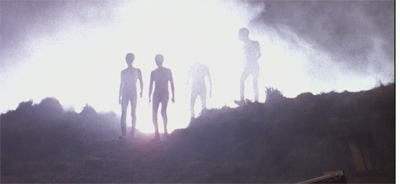

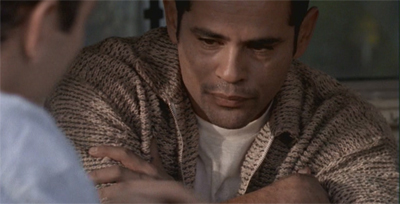

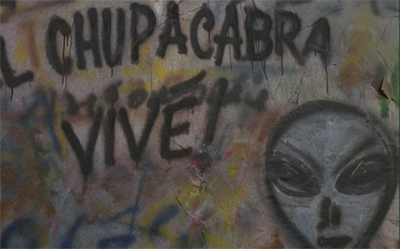

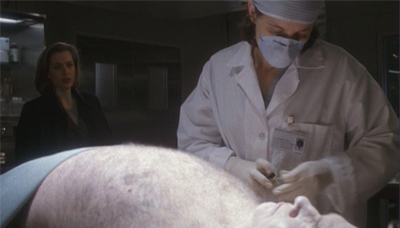
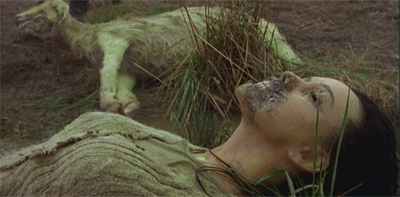


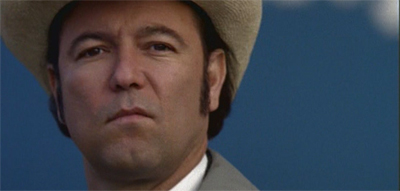
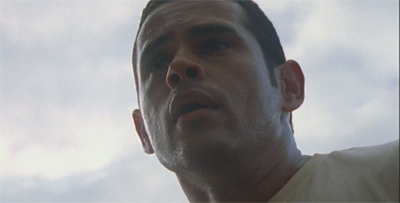

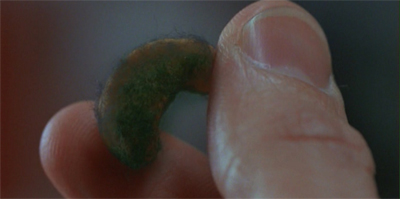


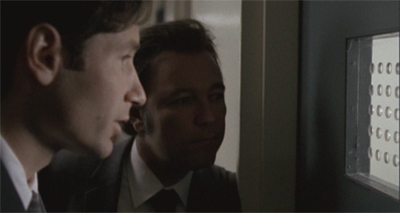





Very thoughtful review. I enjoyed it much more than the episode. The only thing I really remembered about “the chupacabra episode” was Mulder’s comment about Purple Rain (which I kind of agree with). Now I know why it makes all the “worst episodes” lists.
It’s terrible. It’s amazing to think that it got made at all, even back in the mid nineties.
I think you underrate this episode. It’s obviously an attempt to turn it into a Mexican soap opera type episode. Although I have never watched one, the scene that plays on the TV in the barbershop about an overacted piece of Mexican TV show can be seen in so many movies & TV shows.
With the constant six-string guitar Mexican tune that plays almost throughout the episode, it’s clear that episode is not meant as a serious one. Might be an attempt to pull off a Darin Morgan that did not work quite as well as it should have but enjoyable nonetheless.
Well, each’s own. I don’t think that I do. I think it might have been an interesting episode from another staff member, but I think that the episode as it aired is a disaster.
There does seem to be an unconscious racism to some of Shiban’s episodes. Teso Dos Bichos, this one, and Badlaa. I happen to like Badlaa because it is a creep show despite the fact it is pretty poorly written. Shiban scripts tend to have a cultural insensitivity to them that have always bothered me. I say this as someone who adores episodes like Hell Money and Fresh Bones. The problem with this episode is that it has this very ugly idea that immigrants are coming into this country bringing diseases. It is very Trumpian in that regard. There is also that awful scene (Maria! Maria!) in which Mulder mocks the poor immigrant. The Latino characters are all stereotypes, imo. They are treated as the other (same for the butt genie in Badlaa). Trivial people who cling to their silly religions and myths. On the other hand, Shiban keeps hammering us (in the most hamfisted way) with the idea that nobody cares about these people. The whole Mexican soap opera angle was also stupidly offensive, imo. But as I have said before, I do love a lot of his work. Pine Bluff and Elegy are two of my favorite episodes.
I am not a huge fan of Shiban, but he is capable of greatness. The X-Files’ writers’ room as it solidified in the third season is one of the best in the history of television. Even if Shiban is the weakest of the big names, he’s still pretty great on his own terms. Pine Bluff is probably my favourite of his solo scripts.
Absolutely. Pine Bluff is a fantastic piece of television. I don’t mean to diminish Shiban contributions to the series but apparently he was often heavily rewritten by Carter. His scripts with Vince also tend to be strong episodes.
I believe that. Carter lamented having to rewrite twenty of the twenty-four third season scripts. That said, I imagine that Shiban (most likely through reteaming him with other stronger writers consistently) reached the point where he needed less and less rewriting. But it’s a heck of a writers’ room if Shiban is the weak link. (And I’d agree that he is.)